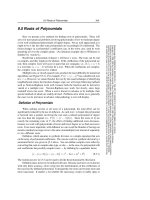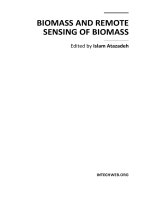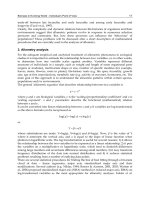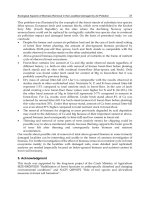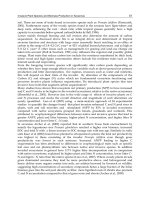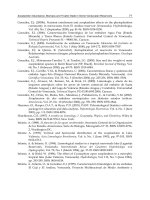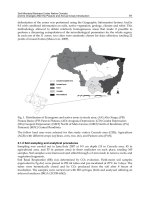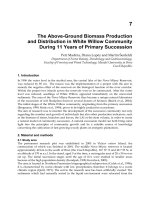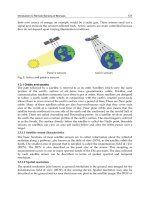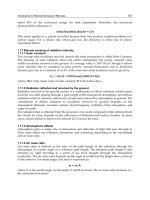Biomass and Remote Sensing of Biomass Part 6 pptx
Bạn đang xem bản rút gọn của tài liệu. Xem và tải ngay bản đầy đủ của tài liệu tại đây (806.43 KB, 20 trang )
Soil Microbial Biomass Under Native Cerrado
and Its Changes After the Pasture and Annual Crops Introduction
91
delimitation of the zones was performed using the Geographic Information System ArcGis
9.0 with combined information on soils, native vegetation, geology, climate and relief. This
methodology allowed to obtain relatively homogeneous areas that made it possible to
perform a discerning extrapolation of the microbiological parameters for the whole region.
In each one of the 11 zones, two cities were randomly chosen for data collection, totaling 22
points of research sites (Maia et al., 2009).
Fig. 1. Distribution of Ecoregions and native areas in study area; (AX) Alto Xingu; (PB)
Parana Basin; (PP) Parecis Plateau; (AD) Araguaia Depression; (CD) Cuiabá Depression;
(DG) Guaporé Depression; (NMT) North of Mato Grosso; (NRO) North of Rondônia; (PA)
Pantanal; (ROC) Central Rondônia.
The follow land uses were selected for this study: native Cerrado area (CER); Agriculture
(AGR) with different crops (soybean, corn, rice, etc); and Pasture area (PAS).
2.1.2 Soil sampling and analytical procedures
Sampling was carried out in June/July 2007 at 0-5 cm depth (15 in Cerrado area, 45 in
agricultural area, and 55 in pasture area) in three replicates on each place, totaling 345
samples. Soil samples were harrowed and sifted through a 2 mm mesh to remove rocks and
vegetation fragments.
Soil Basal Respiration (BR) was determined by CO
2
evolution. Field-moist soil samples
(equivalent to 5g dw) were placed in 250 ml tubes and pre-incubated at 25°C for 3 days. The
tubes were hermetically closed and he CO
2
produced from the soil after 8 hours of
incubation. The samples were carried out with BD syringes (2ml) and analyzed utilizing an
infra-red analyzer (IRGA LICOR-6262).
Biomass and Remote Sensing of Biomass
92
Microbial biomass C (MB-C) was determined by the chloroform fumigation–extraction
method (Vance et al.,1987) with field-moist samples (equivalent to 20 g dw). The filtered soil
extracts of both fumigated and no fumigated samples were analyzed for soluble organic C
using a total organic C analyser (Shimadzu TOC-5000). The MB-C was estimated on the basis
of the difference between the organic C extracted from the fumigated soil and that from the no
fumigated soil (EC). For the quantification of nitrogen in microbial biomass (MB-N), the
extracts were analyzed using the Ninhydrin Method (Jorgensen and Brookes, 1990). Ten
Cerrado areas, 20 agricultural areas and 20 pasture areas were selected, in three replicates on
each place in field conditions and two replicates in laboratory, totaling 300 samples.
The (qCO
2
) metabolic ratio (or specific respiratory rates) was calculated based on
relationship between MB-C and BR.
2.1.3 Results and discussion
The results for the basal respiration between pasture and Cerrado were similar (Table 1).
These results may be related to carbon stocks equivalents, while the different behavior in the
agricultural areas may be related to soil management and the different types of crops that
are found in the region (soybean, corn, rice, coffee, etc.).
Studies show that after some years of cultivation, the total concentration of carbon in the
pasture soil is similar to the native systems (Cerri et al., 1991; Cerri, 2003; Silva, 2004) which
also influences the dynamics of SMB. This fact is due to the large amount of roots present in
the pasture system which allows the increase in SOM content and available substrates for
microorganisms to long-term (Carneiro et al., 2008). Maia (2009) concluded that degraded
pastures in the states of Mato Grosso and Rondonia may provide an increase in the soil
organic C content and consequently promote C sequestration.
Jakelaitis et al. (2008) also reported the same sequence in their studies. According to Ballota
et al. (1998) soil that exhibit high and low values of MB-C:Corg may represent accumulation
or loss of soil carbon, respectively. Those values are consistent with the percentage proposed
by Jenkinson & Ladd (1981) who consider it normal that 1 do 4 % of soil carbon corresponds
to the microbial component. This ratio is reported as an indicator of the quality of SOM
(Wardle, 1994), it allows to monitor the disturbances promoted by the ecological imbalance
and changes in total SOM caused by management, reacting faster than the physical and
chemical indicators (Alvarez et al., 1995).
Studies in different soils and regions found higher values of qCO
2
in native areas (Xavier,
2004; Santos et al., 2004; Fialho et al., 2006). Assessing agroecosystem for 21 years, Mader et
al. (2002) reported a high negative correlation between microbial diversity and qCO
2
. The
lower values observed in pasture (0.76) suggest that these areas have a more efficient
microbial biomass energy use, featuring more stable environment (Chaer, 2001) and also
have higher microbial diversity (Mader et al., 2002). Dinesh et al. (2003) assigns higher
values of qCO
2
due the large amount of C content available for soil microbial degradation.
The higher values of MB-C and MB-N observed in soils under pasture (PAS) in relation to
native area (CER) is due to long time of pasture implantation in these ecoregions (10 to 25
years of establishment). Luizão et al. (1999) studied pastures 2 to 13 years in the Amazon
region and assign that the SMB and BR in the soil superficial layer (0-5 cm) increase until
five years after the pasture establishment. After that a progressive decline occurs until the
eighth year. However, De Vries et al. (2007) shows a positive correlation between SMB
(fungal and bacterial) and the age of pasture.
Soil Microbial Biomass Under Native Cerrado
and Its Changes After the Pasture and Annual Crops Introduction
93
Basal Respiration (ugCO
2
g soil h
-1
)
Mean N S.D. C.V. (%)
AGR 0.37 b 135 0.08 21.44
PAS 0.50 a 165 0.18 38.06
CER 0.46 a 45 0.09 19.17
MB-C (g C kg soil
-1
)
Mean N S.D C.V. (%)
AGR 0.53 b 120 0.21 41.29
PAS 0.69 a 120 0.17 25.29
CER 0.53 b 60 0.29 54.86
MB-N (mg C kg soil
-1
)
Mean N S.D C.V. (%)
AGR 17.85 b 120 16.10 90.19
PAS 37.16 a 120 26.93 71.00
CER 26.56 b 60 18.74 70.55
MB-C: Corg (%)
Mean N S.D C.V. (%)
AGR 2.98 b 100 2.40 49.51
PAS 4.08 a 100 2.50 33.14
CER 3.45 a 20 2.31 67.03
qCO
2
(g CO
2
h
-1
)
Mean N S.D C.V. (%)
AGR 1.01 a 120 0.49 97.14
PAS 0.76 b 120 0.47 45.09
CER 1.02 a 20 0.78 76.52
Table 1. Soil microbial attributes in different areas at Mato Grosso and Rondonia states.
AGR: Agriculture; PAS: Pasture areas; CER: Cerrado; S.D.: Standard Deviation; C.V.:
Coefficient of Variation.
According to Luizão et al. (1999), the biomass of fine roots is a factor that may influence the
response of the microbial attributes in the pasture system, having a positive correlation with
the SMB and the soil water content. The higher BR observed in degraded pastures may be
related to the diversity of invasive plants which have varied root systems, resulting in
greater soil aeration and oxygenation (Grimaldi et al., 1992). Moreover, there is an increase
in nutrient input through litter and exudates produced by different plant species.
The greatest MB-N content in degraded pastures may indicate, indirectly, a change in
taxonomic groups that compose the microbial biomass (Venzke Filho, 1999). The
development of nitrifying microorganisms occurs due to different physical, chemical and
nutritional properties.
Other factor that promotes the development of the SMB in pasture is an intensive livestock,
resulting in an increase in MB-C and MB-N (Wang et al., 2006). The livestock waste acts as a
natural fertilizer and consequently causes reactions in the dynamics of soil microorganisms
(Saviozzi et al., 2001; Iyyemperumal et al., 2007). The microbial biomass is sensitive to
changes in soil organic carbon related to management and land-use-change. After the
Biomass and Remote Sensing of Biomass
94
alterations in the soil, the SMB undergoes fluctuations until a new equilibrium (Polwson et
al., 1987).
To illustrate the dynamics of the microbial attributes within ecoregions, was performed a
study in the Alto Xingu ecoregion. This ecoregion was chosen because it has great
representation in the land-use-change in Southwestern Amazonia. The Alto Xingu is
characterized by livestock and agriculture in the municipality of Sorriso, and the soil is
classified as Oxisols with different clay contents (Belizario, 2008).
The improved pastures (IP) showed higher values of MB-C and BR in relation to degraded
(DP) and typical pastures (TP). The SM-C (Figure 2) values were 0.84 (IP), 0.60 (DP) and 0.53
Fig. 2. Microbial biomass carbon (MB-C) in pasture areas located at Alto Xingu ecoregion. LSD,
Least significant difference; TP, typical pasture; DP, degraded pasture; IP, improved pasture.
Fig. 3. Microbial biomass nitrogen (MB-N) in pasture areas located at Alto Xingu ecoregion. LSD,
Least significant difference; TP, typical pasture; DP, degraded pasture; IP, improved pasture.
Soil Microbial Biomass Under Native Cerrado
and Its Changes After the Pasture and Annual Crops Introduction
95
Fig. 4. Soil basal respiration (BR) in pasture areas located at Alto Xingu ecoregion. LSD,
Least significant difference; TP, typical pasture; DP, degraded pasture; IP, improved
pasture.
gC kg solo
-1
(TP), without statistical differences between DP and TP. The MB-N (figure 3)
showed higher values to IP (41.54 mgN kg solo
-1
), followed by DP (23.36 mgN kg solo
-1
) and
TP (13.29 mgN kg solo
-1
).The BR values (Figure 4) were 0.61 (IP), 0.42 (DP) and 0.46 ugCO
2
gsolo
-1
h
-1
(TP).
The highest values of soil microbial attributes founded in IP may be related to the
application of fertilizers and lime in the study area. Hatch et al. (2000) demonstrated
increases in basal respiration in soils after the application of fertilizers, however, no reported
increases in the MB-C, different that observed in this study.
The fertilizer can initiate a process of "priming effect" on soil, promoting an increase in the
active biomass (r-strategists microorganisms) which die after the exhaustion of the substrate,
or become dormant due to its inability to mineralize the SOM. In contrast, the microbial
biomass of slower growth (k-strategists microorganisms) remains active and increased its
population due the non-degraded fractions by r-strategists microorganisms and also the
substrates provided by cell lyses (Fontaine et al., 2003). The mechanisms of priming effect are
not fully elucidated yet; however competition between r and k-strategists microorganisms can
help to elucidate the dynamics observed in these study areas with pasture.
The increase in pH caused by the lime application promotes an impact in the composition of
SMB. High pH stimulates the activity of nitrifying bacteria which combined with fertilizers
cause the soil acidification, mainly in the superficial layers (Giracca, 2005).
2.2 Soil microbial biomass after the annual crops introduction in Cerrado region
The Cerrado region was incorporated for the grain production because has weather
conditions favorable to cultivate annual crops (soybean, corn, sorghum, etc). Moreover, the
flat topography facilitates the soil management and harvesting of grains.
The pasture and annual crops cultivation are the first land-use-change that have occurred in
large proportions and quite fast in the Amazon region. The expansion of soybean cultivation
Biomass and Remote Sensing of Biomass
96
in the Southwestern of Amazon region has occurred mainly in the Rodonia and Mato Grosso
states. The production of Brazilian soybean was 19 M tons in 1994 and increased to 40 M tons
in 2004, and the Mato Grosso State was the largest contributor to this increase (Brasil, 2009).
It is important to report that the intensive land use reduces the quality of organic matter
remaining in the soil. These changes occur, for example, in the breakdown and destruction of
soil aggregates with losses to erosion, reducing the availability of nutrients to plants and the
water storage capacity. These are some factors that reflect negatively on agricultural
productivity, and consequently on food production and the sustainability of the soil-plant-
atmosphere (Lal. 2003; Six et al., 2004; Knorr et al., 2005). However, Maia (2009) in interviews
with experts noted that occurred a considerable increase in the no-tillage cultivation between
1985 and 2002, and now it is the main crop system adopted in the region.
Microorganisms play an essential role for the decomposition of SOM and its reduction in the
diversity or abundance may affect nutrient cycling (Giller et al., 1998). The microbial activity
is affected by soil management systems, depending how the crop residue is incorporate and
the degree of soil disturbance (Vargas & Scholles, 2000). Thus, is important determine the
changes in soil microbial biomass related to soil management and climate seasonality in the
Cerrado region.
2.2.1 Study areas
The study was carried out at the União Farm (12
o
29’S, 60
o
00’W), a conventional farm with
an area of 3,700 in Rondonia State, Brazil (Figure 5). The native vegetation of the region is
classified as Cerrado, sub-group Cerradão of the dense vegetation type (Ribeiro and Walter,
1998). According to Köppen (1900) the climate is classified as Aw (humid tropical) with
mean temperature of 23.1 °C and a minimum temperature of 18.0 °C during the coldest
month. The region has a well defined dry season (May to September) with a monthly
rainfall below 10 mm, while the mean annual rainfall is 2,170 mm. The mean altitude of the
region is 600 m with undulating relief. The soil was classified as an Oxisol (Typic Hapludox)
with very clayey texture (730 g clay kg
-1
of soil).
Fig. 5. Map of location of the study area in the União Farm, Rondônia State, Amazon region,
Brazil.
Soil Microbial Biomass Under Native Cerrado
and Its Changes After the Pasture and Annual Crops Introduction
97
Areas of about 500 ha of the farm were cleared yearly for cultivation between 1999 and 2004.
(Figure 6). The clearing was done by tractor and blade at the end of the wet season
(May/June). After a drying period of 20 days, aboveground biomass was burnt. Mechanical
windrowing followed this operation and areas were subsequently cleaned by burning
stumps and root residues and removing remaining material. For further soil preparation, a
disc harrow was used to incorporate dolomite lime, which was applied to achieve 50 % base
saturation (V) in the 0-20 cm soil layer. Next, a leveling harrow was used. These initial
preparation steps had been applied to all sampled areas, except for the native Cerrado (used
as control).
Fig. 6. Conversion of Cerradão to agriculture in União farm.
Every newly established area was cultivated with rice under CT. After two years of rice
under CT and associated lime incorporation, leveling and cleaning of the soil surface, a NT
system with soybean was introduced for one to three years. A chronosequence of six
different sites was considered in this study: native Cerrado vegetation (CE), used as a
reference area, a CT system cultivated with rice for 1 year (1CT) and 2 years (2CT), and a NT
system cultivated with soybean for 1 (1NT), 2 (2NT) and 3 years (3NT), always preceded by
a 2-year period of rice under CT alternating either with other crops or fallow land in the
winter season (Table 2). This table also shows the crop cycles, annual application rates of
lime, pH CaCl
2
, available P and V in the 0-30 cm soil layer. Nitrogen fertilization rates and
other nutrient additions in the study area are described in detail in Carvalho et al. (2007).
The areas were located in close proximity (less than 2 km apart from each other), with
similar topography, soil and climate conditions, differing only in the time since clearing and
the setting up of the sites.
2.2.2 Sampling and analytical procedures
Soil sampling was carried out in July 2004 (dry season) and in January 2005 (wet season) in
six areas of approximately 1 ha (100 x 100 m) based on a completely randomized sampling
design with five pseudo replicates in each area. We are considering those as pseudo
replicates, since they came from the same evaluated areas.
Soil samples were taken from 5 profiles at 0-5, 5-10 and 10-20 cm depths in each site. After
air-drying, the samples were sieved at 2 mm. From each sample, 10 g were ground and
sieved at 0.25 mm for determination of Total Organic Carbon (TOC). The determination was
carried according to Nelson & Sommers (1982) using a Carbon Analyzer – LECO
®
CN-2000.
As samples were collected from fixed layers, the C stock calculation needed to be adjusted for
variations in bulk density (BD) after land use changes. Therefore, the methodology described
Biomass and Remote Sensing of Biomass
98
Land
use
Cultivation
period
Main
crop
Winter
crop
Lime Soil
Density
pH
CaCl
2
Available
P
V
Mg ha
-1
g cm
-3
mg dm
-3
%
Continuous
Cerrado
- 0.77 3.8 4.7 3.6
1CT
2003 – 2004 rice (CT) fallow
land
6 1.00 4.5 6.5 24.0
2CT
2002 – 2003 rice (CT) fallow
land
2 0.93 4.5 5.7 20.1
2003 –2004 rice (CT) fallow
land
4
1NT
2001 – 2002 rice (CT) fallow
land
2 1.11 4.7 9.4 32.5
2002 – 2003 rice (CT) fallow
land
2
2003 – 2004 soybean
(NT)
maize 2
2NT
2000 – 2001 rice (CT) fallow
land
2 0.98 5.0 15.4 39.1
2001 – 2002 rice (CT) fallow
land
2
2002 – 2003 soybean
(NT)
sorghum 1
2003 – 2004 soybean
(NT)
millet 1
3NT
1999 – 2000 rice (CT) fallow
land
1 1.14 5.4 29.7 58.9
2000 – 2001 rice (CT) fallow
land
2
2001 – 2002 soybean
(NT)
fallow
land
1
2002 – 2003 soybean
(NT)
maize 0
2003 – 2004 soybean
(NT)
maize 2
Table 2. Cultivation history of the main crops (rice, soybean) and land use in the winter
season in the corresponding cultivation periods under different land use practices annual
lime application rates, pH CaCl
2
, available P and base saturation in the 0-30 cm soil layer.
Source: Carvalho et al. (2009). Where: 1CT and 2CT mean 1 and 2 years of rice under
conventional tillage; 1NT, 2NT and 3NT mean 1, 2 and 3 years of soybean under no-tillage
after a 2-year period of rice under conventional tillage; V means base saturation.
Soil Microbial Biomass Under Native Cerrado
and Its Changes After the Pasture and Annual Crops Introduction
99
in Ellert & Bettany (1996) and Moraes et al. (1996) was used to adjust soil C stocks to an
equivalent soil mass. In order to calculate C stocks in an equivalent soil mass, the depth of
the considered area was adjusted, i.e., the depth of the cultivated areas containing the same
soil mass as the corresponding layer (0-30 cm) in native vegetation (the reference area).
To determine soil microbial biomass and basal respiration, subsamples were carried out
using a grid pattern at five points within a 100m
2
quadrant for each treatment. The soil
subsamples from each treatment were bulked and thoroughly mixed in a plastic bag, and a
composite sample was taken. The composite samples, in five replicates for each treatment,
were transported on ice, in a cooler, to the laboratory. Field moist soils were sieved through
a 2 mm screen, and immediately stored in sealed plastic bags at 4°C.
The samples used for microbial biomass and determination of soil basal respiration (BR)
were adjusted to 55% of the field capacity, considered the ideal soil water content for
studying microbial activity responses. The soil microbial biomass was estimated by the
fumigation-extraction method proposed by Vance et al. (1987). Fumigated and non-
fumigated soil samples were extracted with 0.5 M K
2
SO
4
for 30 min (1:5 soil:extraction ratio),
filtered, and the aliquot was analyzed. The microbial C concentration in the extracts was
obtained by a SHIMADZU TOC 5000-A equipment. The microbial N was determined by the
ninhydrin reactive compound quantification method (Joergensen & Brookes, 1990) using the
conversion factor kEN = 0,65 (Sparling et al., 1993).
The statistical analysis of data was performed on a completely randomized sampling design,
with the assumption that the areas studied had the same topographic, edaphic and climatic
conditions. Six areas with five pseudo replicates were evaluated.
Data from soil C stocks under different areas were analyzed for variance (ANOVA) to
determine land use effects. A Tukey test was used to test significant (p ≤ 0.05) differences
among treatments. All statistical analyses were performed using the SAS program, version 6.
2.2.3 Results and discussion
In the 0–30 cm soil layer, the C stock in CE was 50 Mg ha
-1
, significantly smaller than the
stocks in 1NT and 3NT (p < 0.05), in the dry season (Table 3). Corazza et al. (1999), studying
a clayey Typic Hapludox under Brazilian Cerrado vegetation, measured a soil C stock in the
0-20 cm layer of 39.8 Mg ha
-1
. Resck et al. (2000) measured in a Typic Hapludox under
Brazilian Cerrado a C stock of 61 Mg C ha
-1
in the 0-30 cm soil layer. In a Rhodic Hapludox
with very clayey texture under Cerrado in Dourados (Mato Grosso do Sul State, Brazil),
Salton et al. (2005) measured a soil C stock of 44.5 Mg ha
-1
in the 0-20 cm layer. Bayer et al.
(2006) reported a C stock of 54 Mg ha
-1
in the 0-20 cm layer of a Typic Hapludox (650 g clay
kg
-1
soil) under Cerrado in Brazil. Despite the soil C contents were similar among the
mentioned studies (ranging from 2.5 up to 3.1% comparable to the 2.9% of C for this
research) the soil BD obtained here (weighted mean of 0.77 g cm
-3
in the 0-30 cm soil depth)
was lower than the values reported by Salton et al. (2005) and Bayer et al. (2006). Therefore,
we suggest that the lower soil C stocks presented here are due to the lower BD compared to
the last two studies cited above.
After the conversion of Cerrado into agricultural land, while the soil C stock in 1CT (47.6 Mg
ha
-1
) was significantly smaller than the stocks in 1NT and 3NT (p < 0.05), it is not statistically
different from 2NT (Table 3).
In the wet season, six months after the first soil sampling, there were no significant
differences among the areas in the 0-30 cm soil layer (Table 3). Average soil C stocks in
Biomass and Remote Sensing of Biomass
100
Situations
Soil C Stocks (Mg ha
-1
)
Dry season Wet season
CE
50.0 7.4 b 48.1 2.6 a
1CT
47.6 4.9 b 47.4 7.2 a
2CT
55.4 8.5 ab 58.5 11.0 a
1NT
66.5 6.5 a 65.6 15.4 a
2NT
54.5 5.6 ab 47.4 7.9 a
3NT
67.5 10.3 a 59.0 18.5 a
LSD
(1)
14.49 22.87
CV%
(2)
13.0 21.5
Table 3. Soil C stocks (Mg ha
-1
) in the equivalent soil mass of 30 cm depth under Cerradão in
the dry (July 2004) and wet (January 2005) seasons under Cerrado (CE), conventional tillage
(1CT and 2CT) and no-tillage (1NT, 2NT and 3NT) in Vilhena, Rondonia State, Brazil.
Adapted from: Carvalho et al., (2009).The results are mean (n=5) standard deviation.
Means followed by the same letter are not significantly different according to Tukey’s test at
5 %.
(1)
Least Significant Difference.
(2)
Coefficient of variation
the 0-30 cm were calculated using the data of the two evaluated sampling times (dry and
wet seasons presented). When the average soil C stock was considered, some significant
differences were observed. The C stock in 1CT was significantly smaller (p < 0.05) than the
stocks in 2CT, 1NT and 3NT.
In dry season, the MB-C in the 0-5 cm soil depth was higher in the CE area than the other
situations (Table 4). However, only 1CT and 1NT were significantly lower (p<0.05). In the 5-
10 cm soil layer, was again obtained higher contents of MB-C in CE area, followed by 2CT
and 1NT. At 10-20 cm soil depth there were no significant differences between the situations
evaluated.
The MB-C increased in January 2005. Others studies in the Amazon region (Geraldes ,1995;
Frazão et al., 2010) reported modifications in SMB under different management systems and
seasonal variation, with increases in the wet season.
In the rainy season the MB-C was higher in the CE situation (Table 4). At 0-5 cm, MB-C was
higher in CE, followed 1NT, 1CT, 3NT, 2NT and 2CT. Cerri et al. (1985) found higher MB-C
in native area in relation to cultivated areas, and this fact was linked to increased deposition
of organic residues in soil and the large amount of roots with stimulate the activity of soil
microorganisms, especially in the superficial layers of soil.
In both seasons studied showed the same trends of MB-C reduction with the land-use-
change. Chaga (2000) studying soils in Cerrado region, did not found significant
differences in MB-C values between native forest and NT system. Moreover, Hungria
(1996), in study at Parana State, noted that the MB-C was 50% higher in soil under NT
compared to CT.
A possible explanation for the lower amount of MB-C in NT may be related to short time of
installation this system. Souza et al. (2006) founded similar results, with lower values in NT
than in CT. According to D’Andrea et al. (2001) this occurs in NT areas recently
implemented, where there is initially a reduction of MB-C and then after the stabilization of
NT the result is an increase in soil MB-C.
Soil Microbial Biomass Under Native Cerrado
and Its Changes After the Pasture and Annual Crops Introduction
101
Situation
Microbial biomass carbon (mg C kg soil
-1
)
Dry season (July 2004)
Wet season (January 2005)
0–5 cm 5–10 cm 10–20 cm
0–5 cm 5-10 cm 10-20 cm
CE
713 147 a 644
69 a 421
118 ab
1262
310 a 993
263 a 840 212 a
1CT
354 118 b 342
57 c 338
69 ab
312
146 bc 467
323 bc 679 217 bc
2CT
535 209 ab 521
135 ab 479
61 a
200
25 c 470
103 bc 352 167 bc
1NT
367 87 b 367
91 bc 310
49 b
543
141 b 657
118 ab 655 250 bc
2NT
465 104 ab 307
80 c 280
116 b
228
28 c 307
97 c 239 133 c
3NT
641 183 ab 346
76 c 299
75 b
292
110 bc 244
93 c 364 127 bc
Table 4. Microbial biomass carbon (MB-C) in the dry (July 2004) and wet (January 2005)
seasons under Cerrado (CE), conventional tillage (1CT and 2CT) and no-tillage (1NT, 2NT
and 3NT) in Vilhena, Rondonia State, Brazil. The results represent the mean (n=5)
standard deviation. Means within each column of the same depth followed by the same
letter are not significantly different by the Tukey test (p<0.05).
The content of MB-N was altered by changes in soil moisture (Table 5). Overall, the averages
of MB-N tended to be higher in the CE situation. In dry season, the 0-5 cm layer showed
increase in 3NT, followed CE and 2NT situations. The lowest MB-N contents were obtained
in 1NT.
In the rainy season there was no statistical difference at 0-5 cm soil depth (p<0.05). It was
observed the higher MB-N values in CE at 5-10 cm, and CE and 1NT at 10-20 cm soil
depth.
Situation
Microbial biomass nitrogen (mg N kg soil
-1
)
Dry season (July 2004)
Wet season (January 2005)
0–5 cm 5-10 cm 10-20 cm
0-5 cm 5-10 cm 10-20 cm
CE
47 16 ab 32
9 a 27
8 abc
36
28 a 75
19 a 58 11 a
1CT
21 4 cd 20
4 bc 23
12 ab
27
22 a 35
25 ab 43 22 ab
2CT
28 8 bcd 31
4 ab 33
4 a
22
10 a 24
25 b 32 14 abc
1NT
15 4 d 11
4 c 14
6 d
44
20 a 42
20 ab 47 13 a
2NT
38 5 abc 19
5 bc 20
4 bcd
24
26 a 20
10 b 18 14 bc
3NT
55 17 a 23
8 abc 16
4 cd
28
15 a 22
23 b 14 8 c
Table 5. Microbial biomass nitrogen (MB-N) in the dry (July 2004) and wet (January 2005)
seasons under Cerrado (CE), conventional tillage (1CT and 2CT) and no-tillage (1NT, 2NT
and 3NT) in Vilhena, Rondonia State, Brazil. The results represent the mean (n=5)
standard deviation. Means within each column of th same depth followed by the same letter
are not significantly different by the Tukey test (p<0.05).
Fernandes et al. (1998) in a study at Sete Lagoas, Minas Gerais State, founded the quantity of
the soil MB-N two times higher in NT than in CT.
The ratio between microbial biomass carbon and total organic carbon (MB-C:Corg) has been
considered a good indicator of changes of SOM in the evaluation of soil management
systems (Sá et al., 2001) and reflects the amount of C available for the growth of
microorganisms.
The MB-C:Corg ratio ranged between dry and rainy seasons, confirming the results
obtained by Frazão et al (2010) in a sandy soil in the Amazon region. The MB-C:Corg ratio
Biomass and Remote Sensing of Biomass
102
was highest at 0-10 cm than at 10-20cm soil depth. (Figure 7). Haynes (1999) evaluated
temperate soils and reported a reduction in ratio with the increase of soil depth. In dry
season, considering 0-20 cm layer, the higher MB-C:Corg ratio was observed in CE (1,6%).
The values ranged between 1.4 (2CT) and 0.9% (1NT) in management systems.
Fig. 7. MB-C:Corg ratio (%) in dry and rainy season. Situations evaluated: Cerrado (CE),
Conventional tillage (1CTand 2CT) and No-tillage (1NT, 2NT and 3NT).
In the rainy season the MB-C:Corg ratio in the 0-20 cm soil layer was 2.5, 1.6, 0.8, 2.4, 0.6 and
1.5% for CE, 1CT, 2CT, 2CT, 1NT, 2NT and 3NT, respectively (figure 7). Anderson & Domsh
(1989) evaluated the MB-C:Corg ratio in 134 plots of agricultural experiments to long term in
temperate regions and obtained values between 0.27 and 7.0%.This variation was attributed
to type and management of soil, type of vegetation, sampling season and analytical
conditions. The authors suggested equilibrium values of 2.3% for monoculture and 2.9% for
crop rotation.
However, according to Sá (2001), the MB-C:Corg ratio are lower in tropical regions than in
temperate regions. Cerri et al. (1985) studying an Oxisol in the Amazon region found values
of 0.73% under natural conditions and 0.04% in an area recently cleared and burned. Other
study carried out in Parana State in soil cultivated with soybean under NT system found
values ranging between 0.79 and 1.59% (Colozzi-Filho et al., 2005).
The MB-N:Ntotal ratio represents the mineralizable N fraction, i.e., it expresses the potential
of inorganic N available in the soil for the next crop (McGill et al., 1988).
The ratio between microbial biomass nitrogen and total nitrogen (MB-N:Ntotal) varied in
both seasons (Figure 8). The highest ratios were observed in 3NT, CE and 2NT. In NT
situations (3NT and 2NT) the highest MB-N content were observed at 0-5 cm deep.
Considering the MB-N:Norg ratio (%) at 0-20 cm, the values were 1.5 for CE area, 1.1 for
1CT and 2CT area, 0.6 for 1NT, 1.2 for 2NT and 1.3 for 3NT (Figure 8). In all situations
were observed a reduction in the MB-N:Norg ratio at 10-20 cm compared to the
superficial layers.
In the rainy season were founded the highest contribution of theMB-N into the N stocks.
However, there was oscillation between the situations in the dry season. The MB-N:Ntotal
ratio (%) at 0-20 cm in depth was 2.5 for CE, 2.0 for 1CT, 1.1 for 2CT, 2.9 for 1NT, 0.8 for
2NT and 1,5 for 3NT. The higher MB-N:Ntotal values in the CE and 1PD areas represent
higher inorganic N cycling efficiency and availability in the medium term (Xavier et al.,
2007).
Soil Microbial Biomass Under Native Cerrado
and Its Changes After the Pasture and Annual Crops Introduction
103
Fig. 8. MB-N:Ntotal ratio (%) in dry and rainy season. Situations evaluated: Cerrado (CE),
Conventional tillage (1CTand 2CT) and No-tillage (1NT, 2NT and 3NT).
3. Conclusions
The land-use-change in the Cerrado region for pasture and agricultural purposes using
different soil management systems promote alterations in the microbial components of
soil.
The highest values of MB-C and MB-N were found in the Cerrado and pasture areas. The
permanent soil cover and the lack of soil disturbance with the absence of agricultural
practices produced more favorable conditions for microbial development in those
systems.
The largest variations in the agricultural systems can be attributed more to climatic
seasonality than to differences in the management systems.
In general, it is possible to conclude that soils under native system and agriculture with
minimal disturbance of soil contribute to development and maintenance of soil microbial
attributes.
4. Acknowledgments
The authors thank FAPESP - Fundação de Apoio a Pesquisa do Estado de São Paulo (The State
of São Paulo Research Foundation) and CNPq - Conselho Nacional de Desenvolvimento
Cientifico e Tecnológico (National Council for Scientific and Technological Development) for
concession of scholarships and financial resources.
5. References
Alvarez, R., Diaz, R.A., Barbero, N., Santanatoglia, O.J., Balotta, L.(1995) .Soil organic
carbon, microbial biomass and CO2-C production from tree tillage systems. Soil &
Tillage Research, Vol. 33, pp. 17-28, ISSN 0167-1987
Anderson, T.H., Domsch, K.H., 1990.Application of eco-physiological quotients (qCO2 and
qD) on microbial biomasses from soils of different cropping histories. Soil Biology
&Biochemistry, Vol. 22, pp. 251-255, ISSN 0038-0717
Biomass and Remote Sensing of Biomass
104
Anderson, T.H., Domsch, K.H. (1989). Ratios of microbial biomass carbon to total carbon in
arable soils. Soil Biology &Biochemistry, Vol. 21, pp. 471-479, ISSN 0038-0717
Araújo, A.S.F., Monteiro, R.T.R. (2007). Indicadores biológicos de qualidade do solo.
Bioscience Journal, Vol. 23, pp. 66-75, ISSN 1516-3725
Ballota, E. L.; Colozzi-filho, A.; Andrade, D. S.; Hungria, M. (1998). Biomassa microbiana e
sua atividade em solos sob diferentes sistemas de preparo e sucessão de culturas.
Revista Brasileira de Ciência do Solo, Vol. 22, pp. 641-649, ISSN 0100-0683
Beaudoin, N., Saad, J.K., van Laethem, C., Machet, J.M., Maucorps, J., Mary, B. (2005).
Nitrate leaching in intensive agriculture in Northern France: effect of farming
practices, soils and crop rotations. Agriculture Ecosystems & Environment, Vol. 111,
pp. 292-310, ISSN 0167-8809
Bayer, C. Martin-Neto, L.; Mielniczuk, J., Pavinato, A. (2004). Armazenamento de carbono
em frações lábeis da matéria orgânica de um Latossolo Vermelho sob plantio direto.
Pesquisa Agropecuaria Brasileira, Vol. 39, pp. 677-683, ISSN 0100-204X
Bayer, C., Martin-Neto, L., Mielniczuk, J., Pavinato, A., Dieckow, J. (2006). Carbon
sequestration in two Brazilian Cerrado soils under no-till. Soil & Tillage Research,
Vol. 86, pp. 237-245, ISSN 0167-1987
Bayer, C., Mielniczuk, J. (1999). Dinâmica e função da matéria orgânica, In: Fundamentos da
matéria orgânica do solo: ecossistemas tropicais e subtropicais, G.A Santos;
F.A.O.Camargo (Ed.), pp. 9-26, Gênesis, ISBN 987-43-3175-5, Porto Alegre, Brazil
Bayer, C., Mielniczuk, J., Martin-Neto, L. (2000). Efeito de sistemas de preparo e de cultura
na dinâmica da matéria orgânica e na mitigação das emissões de CO
2
. Rev.
Brasileira de Ciência do Solo, Vol. 24, pp. 599-607, ISSN 0100-0683
Belizario, M. H. (2008). Mudanças no estoque de carbono do solo devido ao uso agrícola da
terra no Sudoeste da Amazônia, MSc. Thesis, Escola Superior de Agricultura “Luiz
de Queiroz”, Piracicaba, São Paulo, Brazil.
Brazil. Ministério da Agricultura, Abastecimento e Agropecuária, (2009), Date of access: May 20
2009, Available from: <
Carneiro, M C.; Assis, P.C.R; Melo, L.B.C.; Pereira, H.S.; Paulino, H.B.; Silveira Neto, A.N.
(2008). Atributos bioquímicos em dois solos de Cerrado sob diferentes sistemas
de manejo e uso. Pesquisa Agropecuária Tropical, Vol. 38, pp. 276-283, ISSN 1517-
6398
Carvalho, J.L.N.; Cerri, C.E.P.; Cerri, C.C.; Feigl, B.J.; Piccolo, M.C.; Godinho, V.; Herpin, U.
(2007). Changes of chemical properties in an Oxisol after clearing of native Cerrado
vegetation for agricultural use in Vilhena, Rondonia State, Brazil. Soil & Tillage
Research, v. 96, pp. 95-102, ISSN 0167-1987
Carvalho, J.L.N.; Cerri, C.E.P.; Feigl, B.J.; Piccolo, M.C.; Godinho, V.P.; Cerri, C.C. (2009).
Carbon sequestration in agricultural soils in the Cerrado region of the Brazilian
Amazon. Soil & Tillage Research, Amsterdam, v.103, p.342-349, ISSN 0167-1987
Cerri, C. E. P.; Coleman, K ; Jenkinson, D. S. Bernoux, M. Victoria, R., Cerri, C. C. (2003).
Modeling Soil Carbon from Forest and Pasture Ecosystems of Amazon, Brazil. Soil
Science Society of America Journal, Vol. 67, pp.1879-1887, ISSN 1435-0661
Cerri, C.C.; Eduardo, B.P.; Piccolo, M.C. (1991). Use of stable isotopes in soil organic matter
studies, Proceedings of International Symposium on the use of stable isotopes in plant
Soil Microbial Biomass Under Native Cerrado
and Its Changes After the Pasture and Annual Crops Introduction
105
nutrition, soil fertility and environmental studies, ISBN 9-2001-0391-X, Vienna,
October 1990
Cerri, C.C.; Feller, C.; Balesdent, J.; Victoria, R.; Plenecassagne, A. (1985). Application du
traçage isotopique naturel en
13
C, à l’ étude de la dynamique de la matière
organique dans sols. Comptes Rendu Academic Seances Paris, Vol. 9, pp. 423-428, ISSN
0764-4442
Chaer, G. M. (2001). Modelos para determinação de índice de qualidade do solo baseado em
indicadores físicos, químicos e biológicos, MSc. Thesis, Universidade Federal de
Viçosa, Viçosa, Brazil
Chaga, R.C.S. (2000). Alterações de parâmetros microbiológicos do solo em função do
sistema de produção sob plantio direto na região dos cerrados, MSc. Thesis, Centro
de Energia Nuclear na Agricultura, Piracicaba, Sao Paulo, Brazil
Colozzi-Filho, A.; Andrade, D.S.; Balota, E.L; Hungria,M. (2005). Biomassa microbiana do
solo no agrossistema soja orgânica em plantio direto. Procedings of Simposio sobre
plantio direto e meio ambiente, ISBN 9-78997-40583-9, Foz do Iguaçu, May 2005
Coser, T. R.; Ramos, M.L.G.; Amabile, R.F. (2007). Microbial biomass nitrogen in cerrado soil
with nitrogen fertilizer application. Pesquisa Agropecuária Brasileira, Vol. 42, No. 3,
ISSN 0100-204X
Corazza, E.J., Silva, J.E.D., Resck, D.V.S., Gomes, A.C. (1999). Comportamento de
diferentes sistemas de manejo como fonte ou depósito de carbono em relação à
vegetação de Cerrado. Revista Brasileira de Ciência do Solo, Vol. 23, pp. 425-432,
ISSN 0100-0683
D’Andréa, A.F. (2001). Atributos indicadores da qualidade do solo em sistemas de manejo
no sul de Goiás. MSc Thesis, Universidade Federal de Lavras, Lavras, Brazil
De Vries, S.T.; Bloem, J.; Eekeren, N.; Brusaard, L.; Hoffland, E. (2007). Fungal biomass in
pastures increase with age and reduced N input. Soil Biology and Biochemistry, Vol.
39, pp. 1620-1630, ISSN 0038-0717
Dinesh, R.; Ghoshal Chaudhuri, S.; Ganeshamurthy, A.N.; Dey, C. (2003). Changes in soil
microbial indices and their relationships following deforestation and cultivation in
wet tropical forests. Applied Soil Ecology, Vol. 24, pp. 17–26, ISSN 0929-1393
Ellert, B.H.; Bettany, J.R. (1996). Calculation of organic matter and nutrients stored in soils
under contrasting management regimes. Canadian Journal of Soil Science, Vol. 75, pp.
529-538, ISSN 1918-1841
Feller, C., Beare, M. H. (1997). Physical control of soil organic matter dynamics in the tropics.
Geoderma, Vol. 79, pp. 69-116, ISSN 0016-7061
Ferreira, E.A.B., Resck, D.V.S., Gomes, A.C., Ramos, M.L.G. (2007). Dinâmica do carbono da
biomassa microbiana em cinco épocas do ano em diferentes sistemas de manejo do
solo no Cerrado. Revista Brasileira de Ciência do Solo, Vol. 31, pp. 1625-1635, ISSN
0100-0683
Fernandes, M.F.; Fernandes, R.P.M.; Anjos, J.L.; Sobral, L.F Araujo, A.S. (1998). Efeito da
saturação por bases sobre a atividade de fosfatases em um solo de tabuleiro costeiro
cultivado com citros. II. Constantes cinéticas das enzimas. Revista Brasileira de
Ciência do Solo, Vol. 22, pp. 403-410, ISSN 0100-0683
Biomass and Remote Sensing of Biomass
106
Fialho, J.S.; Gomes, V.F.F.; Oliveira. T.S.; Silva Júnior, J.M.T. (2006) Indicadores da qualidade
do solo em áreas de vegetação natural e cultivo de bananeiras na Chapada do
Apodi – CE. Revista de Ciência Agronômica, Vol. 37, pp. 250-257, ISSN 1806-6690
Figueiredo, C.C., Resck, D.V.S., Gomes, A.C., Ferreira, E.A.B., Ramos, M.L.G. (2007).
Carbono e nitrogênio da biomassa microbiana em resposta a diferentes sistemas de
manejo em um Latossolo Vermelho no Cerrado. Revista Brasileira de Ciência do Solo,
Vol. 31, pp. 551-562, ISSN 0100-0683
Fontaine, S., Mariotti, A., Abbadie, A. (2003). The priming effect of organic matter: a
question of microbial competition? Soil Biology and Biochemistry, Vol.35, pp. 837-843,
ISSN 0038-0717.
Frazão, L.A. Piccolo, M.C., Feigl, B.J, Cerri, C.C.; Cerri, C.E.P. (2010) Inorganic nitrogen,
microbial biomass and microbial activity of a sandy Brazilian Cerrado soil under
different land uses. Agriculture, Ecosystems & Environment, Vol. 135, pp. 161-167,
ISSN 0167-8809
Gama Rodrigues; Barros E.F.; Gama-Rodrigues, N.F.; Santos, A.C. (2005). Nitrogênio,
carbono e atividade da biomassa microbiana do solo em plantações de eucalipto.
Revista Brasileira de Ciência do Solo, Vol. 29, pp. 893-901, ISSN 0100-0683
Geraldes, A.P.A.; Cerri, C.C.; Feigl, B.J. (1995). Biomassa microbiana de solo sob
pastagens na Amazônia. Revista Brasileira de Ciência do Solo, Vol. 19, pp. 55-60,
ISSN 0100-0683
Giller, K.E., Witter, E., McGrath, S.P. (1998). Toxicity of heavy metals to microorganisms and
microbial process in agricultural soils: a review. Soil Biology and Biochemistry, Vol.
30, pp. 1389-1414, ISSN 00380717.
Giracca, E.M.N. (2005). Efeito do calcário em atributos microbiológicos do solo. PhD. Thesis,
Universidade Federal de Santa Maria, Santa Maria, Brazil
Grimaldi, M.; Sarrazin, M.; Chauvel, A.; Luizão, F.; Rodrigues, M.R. (1992). Efeitos da
vegetação e da ação do homem sobre a estrutura dos latossolos argilosos da
Amazônia Brasileira, Proceedings of The first International Symposium on
Environmental Studies on Tropical Rainforests, Rio de Janeiro, October 1992
Hatch, D.J., Lovell, R.D., Antil, R.S., Jarvis, S.C. (2000). Nitrogen mineralization and
microbial activity in permanent pastures amended with nitrogen fertilizer or dung.
Biology & Fertility Soils, Vol. 30, pp. 288–293, ISSN 0178-2762
Haynes, R.J. Size and activity of the soil microbial biomass under grass and arable
management. (1999). Biology & Fertility Soils, Vol. 47, pp. 245-251, ISSN 0178-
2762
Ingram, L.J.; Schuman, G.E.; Stahl, P.D.; Spackman, L.K. (2005). Microbial Respiration and
Organic Carbon Indicate Nutrient Cycling Recovery in Reclaimed Soils. Soil Science
Society of America Journal, Vol. 69, pp. 1737-1745, ISSN 0361-5995
International Panel on Climate Change (IPCC). (2007). Guidelines for national greenhouse
gas inventories. Date of Access: April 26 2008, Available from:
< c- nggip.iges.or.jp/public/2006gl/index.html>
Iyyemperumal, K.; Israel, D.W.; Shi, W. (2007). Soil microbial biomass, activity and potential
nitrogen mineralization in a pasture: Impact of stock camping activity. Soil Biology
and Biochemistry, Vol. 39, pp. 149-157, ISSN 0038-0717.
Soil Microbial Biomass Under Native Cerrado
and Its Changes After the Pasture and Annual Crops Introduction
107
Jackson, L.E., Calderon, F.J., Steenwerth, K.L., Scow, K.M., Rolston, D.E. (2003). Responses of
soil microbial process and community structure to tillage events and implications
for soil quality. Geoderma, Vol. 114, pp. 305-317, ISSN 0016-7061
Jakelaitis, A.; da Silva, A.A.; dos Santos, J.B.; Vivian, R. (2008). Qualidade da camada
superficial de solo sob mata, pastagens e áreas cultivadas. Pesquisa Agropecuária
Tropical, Vol. 38, pp. 118-1127, ISSN 1517-6398
Jenkinson, D.S. (1988). Determination of microbial biomass carbon and nitrogen in soil. In:
Advances in Nitrogen Cycling in Agricultural Ecosystems, J.R. Wilson, (Ed.), pp. 368-
386, CAB International, ISBN 0-8519-8603-X, New York, USA
Jenkinson, D. S. & Ladd, J. N. (1981). Microbial biomass in soil. Measurement and turnover,
In: Soil Biochemistry, E.A. Paul.; J.M. Ladd, (Ed.), Vol.5, pp.415-471, Dekker, ISBN 0-
8247-11131-9, New York, USA
Joergensen, R.G; Brookes, P.C. (1990). Ninhydrin-reactive nitrogen measurements of
microbial biomass in 0,5 M K2SO4 soil extracts. Soil Biology and Biochemistry, Vol.
22, pp. 1023-1027, ISSN 0038-0717
Kaschuk, G.A.; Hungria.; M. (2010). Three decades of soil microbial biomass studies in
Brazilian ecosystems: Lessons learned about soil quality and indications for
improving sustainability. Soil Biology and Biochemistry, Vol. 42, No. 1, January 2010,
ISSN 0038-0717
Knorr, W., I.C. Prentice, J.I. House, and E.A. Holland. (2005). Long-term sensitivity of soil
carbon turnover to warming. Nature, Vol. 433, pp. 298-301, ISSN 0028-0836
Koppen, W. Versucheiner Klassification der Klimate, vorzugsweise nach ihren Beziehungen
zur Pflanzenwelt. (1900). Geographische Zeitschrift, Vol. 6, pp.593-611, ISSN 0016-
7479
Lal, R. (2003). Global potential of soil carbon sequestration to mitigate the greenhouse effect.
Critical Reviews in Plant Science, Vol. 22, pp. 151-184, ISSN 0735-2689
Luizão, R.C.C.; Costa, E. S.; Luizão, F. J. (1999). Mudanças na biomassa microbiana e nas
transformações de nitrogênio em uma seqüência de idades de pastagens após
derruba e queima da floresta na Amazônia Central. Acta Amazônica, Vol. 29, pp. 43-
56, ISSN 0044-5967
Mader, P.; Fliebach, A.; Dubois, A.; Gunst, L.; Fried, P.; Niggli, U. (2002). Soil fertility and
biodiversity in organic farming. Science, Vol. 296, pp. 4, ISSN 1095-9203
Maia, S.M.F. (2009). Estimativas das emissões de carbono do solo devido à mudanças de uso
da terra no uso da terra em Rondônia e Mato Grosso, PhD thesis, Escola Superior
de Agricultura “Luiz de Queiroz”, Piracicaba, São Paulo, Brazil
Matsuoka, M.; Mendes, I. C.; Loureiro, M. F. (2003). Biomassa microbiana e atividade
enzimática em solos sob vegetação nativa e sistemas agrícolas anuais e perenes na
região de Primavera do Leste (MT). Revista Brasileira de Ciência do Solo, Vol. 27, No.
3, pp. 425-433, ISSN 0100-0683
McGill, W.B., Dormaar, J.E., Reinl-Dwyer, E. (1988). New perspective on soil organic matter
quality, quantity and dynamics on the Canadian prairies. Proceedings of 43th Annual
Meeting of the Canadian Society of Soil Science, ISBN 3-8359-5384-2, Calgary, August
1988
Biomass and Remote Sensing of Biomass
108
Mello, F.F.C. (2007). Estimativas dos estoques de carbono dos solos nos Estados de
Rondônia e Mato Grosso anteriores à intervenção antrópica, MSc thesis, Escola
Superior de Agricultura “Luiz de Queiroz”, Piracicaba, São Paulo, Brazil
Mielniczuk, J., Wünsche, W.A., Ferreira, T. (1983). Conservação do solo. Revista Trigo e Soja,
Vol. 66, pp. 17-21, ISSN 1517-4964
Moraes, J.F.L.; Volkoff, B.; CerriI, C.C.; Bernoux, M. (1996). Soil properties under Amazon
forest and changes due to pasture installation in Rondônia, Brazil. Geoderma, Vol.
70, pp. 63-81, ISSN 0016-7061
Nelson, D.W.; Sommers, L.E. Total carbon, organic carbon and organic matter. (1982). In:
Methods of soil analysis, A.L. Page; R.H. Miller; D.R. Keeney (Ed.), pp. 539-579,
American Society of Agronomy, ISBN 0-8911-8088-5, Madison, USA
Neill, C., Piccolo, M.C., Steudler, P.A., Melillo, J.M., Feigl, B.J., Cerri, C.C. (1995). Nitrogen
dynamics in soils of forests and active pastures in the Western Brazilian Amazon
Basin. Soil Biology &Biochemistry, Vol. 27, pp. 1167-1175, ISSN 0038-0717
Perez, K.S.S.; Ramos, M.L.G.; McManus, C. (2004). Carbono da biomassa microbiana em solo
cultivado com soja sob diferentes sistemas de manejo nos cerrados. Pesquisa
Agropecuária Brasileira, Vol.39, pp. 567-573, ISSN 0100-204X
Resck, D.V.S., Vasconcellos, C.A., Vilela, L., Macedo, M.C.M. (2000). Impact of conversion of
Brazilian Cerrados to cropland and pasture land on soil carbon pool and dynamics.
In: Global climate change and tropical ecosystems, R. Lal; J.M. Kimble; B.A. Stewart
(Ed.), pp. 169-196, CRC Press, ISBN 9-781566-70485-4 , Boca Raton, USA
Ribeiro, J.F.; Walter, B.M.T. (1998). Fitofisionomias do bioma Cerrado. In: Cerrado: ambiente e
flora, S.M. Sano; S.P. de Almeida (Ed.), pp. 89-166, EMBRAPA, ISBN 8570750080,
Brasília, Brazil
Roscoe, R., Vasconcellos, C.A., Furtini-Neto, A.E., Guedes, G.A.A., Fernandes, L.A. R.
(2000). Uréase activity and its relation to soil organic matter, microbial biomass
nitrogen and urea-nitrogen assimilation by maize in a Brazilian Oxisol under
no-tillage and tillage systems. Biology & Fertility Soils, Vol. 32, pp. 52-59, ISSN
0178-2762
Sa, J.C.; Cerri, C.C; Dick, W.A.; Lal, R.; Venzke Filho, S.P.; Piccolo, M.C.; Feigl, B.J. (2001).
Organic matter dynamics and carbon sequestration rates for a tillage
chronosequence in a Brazilian oxisol. Soil Science Society of America Journal, Vol. 65,
pp. 1486-1499, ISSN 1435-0661
Salton, J.C., Mielniczuk, J., Bayer, C., Fabrício, A.C., Macedo, M.C.M., Broch, D.L., Boeni, M.,
Conceição, P.C. (2005). Matéria Orgânica do Solo na Integração Lavoura-Pecuária em
Mato Grosso do Sul, EMBRAPA, Retreived from
<>
Santos, V,B.; Castilhos, D.D.; Castilhos, R.M.V.; Pauletto, E.A.; Gomes, A.S; Silva, D.G.
(2004). Biomassa, Atividade microbiana e teores de carbono e nitrogênio totais de
um planossolo sob diferentes sistemas de manejo. Revista Brasileira de Agrociência,
Vol. 10, pp. 333-338, ISSN 0104-8996
Saviozzi, A.; Levi-minzi, R.; Cardelli, R.; Riffaldi, R. A (2001). Comparison of soil quality in
adjacent cultivated, Forest and native grassland soils. Plant and Soil, Vol. 233, pp.
251-259, ISSN 0032-079X
Soil Microbial Biomass Under Native Cerrado
and Its Changes After the Pasture and Annual Crops Introduction
109
Silva. J. E., Lemainski, J., Resck, D. V. S. (1994). Perdas de matéria orgânica e suas
relações com a capacidade de troca catiônica em solos da região de cerrados do
oeste baiano. Revista Brasileira de Ciência do Solo, Vol. 18, pp. 541-547, ISSN 0100-
0683
Silva, J.E.; Resck, D.V.S.; Corazza, E.J.; Vivaldi, L. (2004). Carbon storage in clayey oxisol
cultivated pastures in the “Cerrado” region, Brazil. Agriculture Ecosystems &
Environment, Vol. 103, pp. 357-363, ISSN 0167-8809
Six, J., S.M. Ogle, F.J. Breidt, R.T. Conant, A.R. Mosier, and K. Paustian. (2004). The potential
to mitigate global warming with no-tillage management is only realized when
practised in the long term. Global Change Biology, Vol. 10, pp. 155-160, ISSN 1354-
1013
Souza, E. D.; Carneiro, M. A. C.; Paulino, H. B.; Silva, C. A. (2006). Frações do carbono
orgânico, biomassa e atividade microbiana em um Latossolo Vermelho sob cerrado
submetido a diferentes sistemas de manejos e usos do solo. Acta Scientiarum
Agronomy, Vol. 28, No. 3, pp. 323-329, ISSN 1679-9275
Sparling, G. (1992). Ratio on microbial biomass carbon to soil organic carbon as a sensitive
indicator of changes in soil organic matter. Australian Journal of Soil Research, Vol.
30, pp. 195-207, ISSN 0004-9573
Sparling, G.P., Grupta, V.V.R., Zhu, C. (1993). Release of ninhydrinreactive compounds
during fumigation of soil to estimate microbial C and N. Soil Biology & Biochemistry,
Vol. 25, pp. 1803–1805, ISSN 0038-0717
Vance, E.D.; Brookes, P.C.; Jenkinson, D.S. (1987). An extration method for measuring soil
microbial biomass C. Soil Biology & Biochemistry, Vol. 19, pp. 703-707, ISSN 0038-
0717
Vargas, L.K., Scholles, D. (2000). Biomassa microbiana e produção de C-CO
2
e N mineral de
um solo Podzólico Vermelho-Escuro submetido a diferentes sistemas de manejo.
Revista Brasileira de Ciência do Solo, Vol. 24, pp. 35-42, ISSN 0100-0683
Venzke filho, S. P. (1999). Microbiota e sua atividade em uma cronosseqüencia sob sistema
de plantio direto, MSc thesis, Escola Superior de Agricultura “Luiz de Queiroz”,
Piracicaba, São Paulo, Brazil
Wang, K.H.; Mcsorley, R.; Bohlen, P.; Gathumbi, S.M. (2006). Cattle grazing increases
microbial biomass and alter soil nematode communities in subtropical pastures.
Soil Biology & Biochemistry, Vol.38, pp. 1956-1965, ISSN 0038-0717.
Wardle, D.A. (1994). Metodologia para quantificação da biomassa microbiana do solo. In:
Manual de métodos empregados em estudos de microbiologia agrícola, M. Hungria; R.S.
Araújo (Ed.), pp. 419-436, EMBRAPA, Retreived from
<
Xavier, F. A. S. (2004). Compartimentos da matéria orgânica do solo em sistemas agrícola
convencional e orgânico na região da Chapada da Ibiapaba-CE. MSc. Thesis,
Universidade Federal do Ceará, Fortaleza, Brazil
Xavier, F.A.S., Maia, S.M.F., Oliveira, T.S., Mendonça, E.S. (2007). Biomassa microbiana e
matéria orgânica leve em solos sob sistemas agrícolas orgânico e convencional na
Chapada da Ibiapaba – CE. Revista Brasileira de Ciência do Solo, Vol. 30, pp. 247-258,
ISSN 0100-0683
Biomass and Remote Sensing of Biomass
110
Zaman, M.; Cameron, K.C.; Di, H.J.; Inubushi, K. (2002). Changes in mineral N, microbial
biomass and enzyme activities in different soil depths after surface applications of
dairy shed effluent and chemical fertilizer. Nutrient Cycling in Agroecosystems, Vol.
63, pp. 275-290, ISSN 1385-1314
